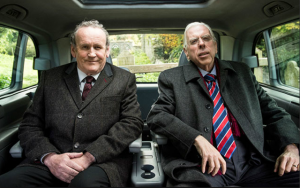THE JOURNEY: 2 ½ STARS. “film takes on the tone of a buddy movie.”
 To understand “The Journey” you need to know the players. The film, a speculative look at the negotiations that brought peace to Northern Island after forty years of violence, does a good job of setting the stage but in the interests of clarity, or if you miss the movie’s opening minutes, I’ll give you the Coles Notes.
To understand “The Journey” you need to know the players. The film, a speculative look at the negotiations that brought peace to Northern Island after forty years of violence, does a good job of setting the stage but in the interests of clarity, or if you miss the movie’s opening minutes, I’ll give you the Coles Notes.
Set in 2006, the film sees Colm Meaney as Martin McGuinness, the former chief of staff of the Irish Republican Army (“Allegedly,” he says) and Sinn Féin politician. “You may call me the acceptable face of the organization,” he says. Timothy Spall is Ian Paisley, the eighty-one-year-old leader of the Democratic Unionist Party and founder and moderator of the Free Presbyterian Church. The two are sworn enemies—“They are civil war,” says MI5’s Harry Patterson (John Hurt), “they are anarchy.”—warriors on opposite sides of a bloody decades long war known colloquially as The Troubles.
Northern Irish director Nick Hamm and writer Colin Bateman play fast-and-loose with the details. In real life the men met on an airplane. In reel life the film finds a contrivance to place the two in the back of a car, on a sixty-minute trip to the Edinburgh airport. MI5 secretly arranged the meet in hopes the men will discover what they have in common, that barriers will be broken down and that some sort of pact will be reached. It doesn’t start well. “I haven’t spoken to him in thirty years,” snorts Paisley, “another hour will be no trouble.”
History tells us the conversation led to the 2006 St. Andrews Agreement and an end to The Troubles. “We need a leap of faith,” says McGuinness, “and you are a man of faith.” The film shows the head-to-head that led to the treaty; how the two began as egotistical enemies and ended as friends and allies in a new, shared Northern Irish government.
“The Journey” is essentially a two-hander between Meany and Spall. There are others characters—Freddy Highmore as a British agent masquerading as their driver, Hurt as the architect of the scheme—but the movie hinges on the chemistry between its leads. Both hand in sturdy, theatrical performances as they spar, like two heavyweights trading words instead of punches. It often feels like a play adapted for the screen.
Spall is all bluster and religious rage. Meany plays McGuinness as a canny but pliable politician, resolute in his beliefs but hopeful for a deal. Each hand in interesting work but their conversation often feels like history in point form. The passing along of this information feels artificial and drains much of the juice from the situation. The script zips along, never digging too deep, which given the performances is a shame. These actors are hungry for a meatier script but Bateman’s dialogue doesn’t deliver.
Despite the performances “The Journey’s” take on the St. Andrews Agreement feels false. By the time Patterson shrieks, “Bloody hell, they’ve done it! They’ve bloody done it!” the film takes on the tone of a buddy movie and not a persuasive document of how peace came to Northern Ireland.
